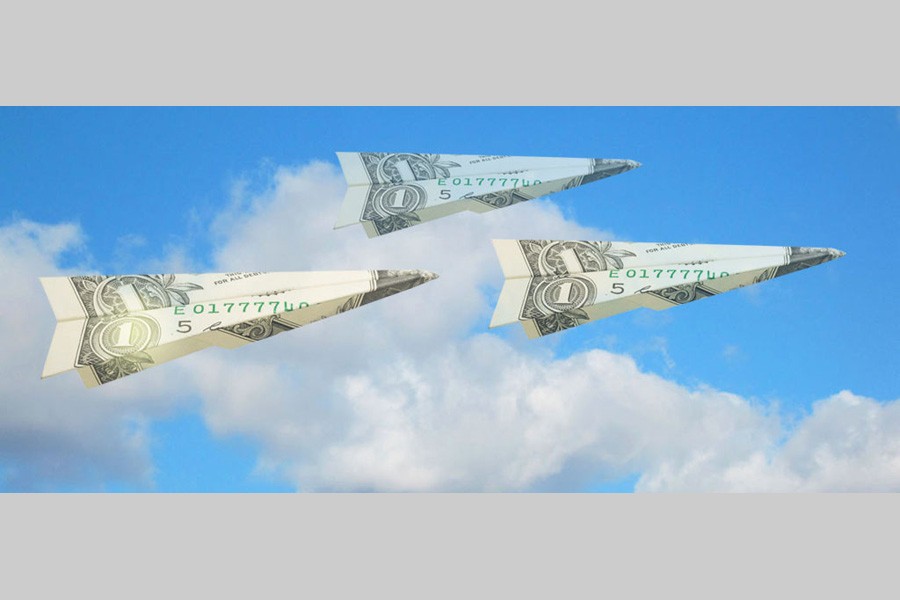So, here we are again. Making headlines on money flight! Not into the thin air of course. Stories on the subject have been doing the rounds in local and international media for quite sometime. Concerns were raised from various quarters, and over time it seems as though all we are now left with is this 'concern'-- a cyclic expression of frustration, perhaps of anger too. The issue, because of its enormity and scale, has been receiving media focus for quite a while -- set off by rough estimates made by international bodies about the money flown off the country to so-called tax heavens and overseas financial institutions.
The latest volley came from the Washington-based Global Financial Integrity (GFI) which in its report released the other day says that at least US$ 5.90 billion flew out of Bangladesh in 2015 through misinvoicing in trading with advanced economies. The report titled 'Illicit Financial Flows to and from 148 Developing Countries: 2006-2015' also mentioned that in the same year illegal financial inflows from other countries to Bangladesh was to the tune of $2.8 billion. GFI's measuring of illicit financial flows stems from two sources. One is deliberate misinvoicing in merchandise trade, and the other is leakages in the balance of payments or hot money flows. In its earlier report, released in 2017, GFI mentioned that annual average illicit capital outflow from Bangladesh stood at $7.58 billion during 2005-2014, and in 2014 alone, the amount was $9.10 billion. It may be noted that the latest GFI report did not take into account flight of money from all sources but confined its research to misinvoicing in trade transactions with advanced countries only.
While the report refers to misinvoicing, it obviously means under-invoicing in export and over-invoicing in import. Here, it may also be noted that although Bangladesh's export is overwhelmingly destined to advanced countries (around 90 per cent), the bulk of its import (close to 70 per cent) is sourced from developing countries such as China and India. This may be a clear pointer that the money gone could be much more had the calculations included total merchandise trade of the country with all trading partners-advanced and developing.
"Fraudulent manipulation of the price, quantity, or quality of a good or service on an invoice allows criminals, corrupt government officials, and commercial tax evaders to shift vast amounts of money across international borders quickly, easily, and almost in an undetected way", the GFI report added. The GFI also said illicit outflows of all the developing countries stood at around $600 billion in 2015.
Capital flight imbedded in the country's trading practices -- especially import -- is yet to face any tough challenge, although monitoring at various levels can identify the modes of operation and effectively take measures to stop the fraudulent activity. There were occasions in the past when this crooked practice was attributed to fake imports showing highly inflated bills through overinvoicing. One clear indicator that makes one suspicious is alleged imports that neither matches the demands of local market nor of the industrial sector. This was the case with the sudden surge in 'import' of capital machinery some years ago. Ground reality at that time did not suggest that imports actually took place or if at all, not in such huge volumes.
Call it money laundering or capital flight, it is well established that every year, $8.0 to $9.0 billion reportedly fly away from the country, and that 80 per cent of this is orchestrated through manipulating invoices. The National Board of Revenue (NBR) and the Central Bank are obviously the agencies on which the onus is more than on any other state bodies to address the problem. Understandably, all it takes is close coordination between the two agencies, preferably by means of jointly tracking suspicious imports - from the stage of opening of letters of credit to clearance of goods. Beside the additional burden of import payments arising from the illegal practice, it is also responsible for discouraging investment at home.
Capital flight is not a new phenomenon, and no wonder, it has reached out to most geographic zones, particularly in those with weak financial management systems. However, it's strange that despite repeated alarm calls, the relevant authorities in Bangladesh are yet to conclusively detect a single incident of the fraudulent practice. Sometime ago, there were media reports that the government was going for a mechanism to bring back huge amount of money siphoned off the country through various conduits, including false trade declarations. An inter-agency taskforce was also restructured for gearing up the efforts. Progress of work of the task force is not known. The key question is: what precisely would form the basis for the taskforce to work on? The job is challenging for the simple reason that there is no one or two known modes through which money flies from the country. People from various affluent segments of society are allegedly involved in siphoning off money-- billions of taka every year through various means. It is not only confined to false trade declarations - over-invoicing in import for example, or capital flight by multinationals-- once believed to be the key mode of money flight, but a widening gyre that among others includes the most practised mode of money transfer called hundi.
It is no doubt experts' job to suggest or work out effective mechanisms to address the problem. Collaboration with international agencies as well as countries facing similar money flight could provide helpful insight into ways of and means to tackling the problem.


